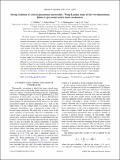Strong violation of critical phenomena universality: Wang-Landau study of the two-dimensional Blume-Capel model under bond randomness
Author(s)
Malakis, A.; Berker, A. Nihat; Hadjiagapiou, I. A.; Fytas, N. G.
DownloadMalakis-2009-Strong violation of.pdf (1.033Mb)
PUBLISHER_POLICY
Publisher Policy
Article is made available in accordance with the publisher's policy and may be subject to US copyright law. Please refer to the publisher's site for terms of use.
Terms of use
Metadata
Show full item recordAbstract
We study the pure and random-bond versions of the square lattice ferromagnetic Blume-Capel model, in both the first-order and second-order phase transition regimes of the pure model. Phase transition temperatures, thermal and magnetic critical exponents are determined for lattice sizes in the range L=20–100 via a sophisticated two-stage numerical strategy of entropic sampling in dominant energy subspaces, using mainly the Wang-Landau algorithm. The second-order phase transition, emerging under random bonds from the second-order regime of the pure model, has the same values of critical exponents as the two-dimensional Ising universality class, with the effect of the bond disorder on the specific heat being well described by double-logarithmic corrections, our findings thus supporting the marginal irrelevance of quenched bond randomness. On the other hand, the second-order transition, emerging under bond randomness from the first-order regime of the pure model, has a distinctive universality class with ν=1.30(6) and β∕ν=0.128(5). These results amount to a strong violation of universality principle of critical phenomena, since these two second-order transitions, with different sets of critical exponents, are between the same ferromagnetic and paramagnetic phases. Furthermore, the latter of these two sets of results supports an extensive but weak universality, since it has the same magnetic critical exponent (but a different thermal critical exponent) as a wide variety of two-dimensional systems with and without quenched disorder. In the conversion by bond randomness of the first-order transition of the pure system to second order, we detect, by introducing and evaluating connectivity spin densities, a microsegregation that also explains the increase we find in the phase transition temperature under bond randomness.
Date issued
2009-01Department
Massachusetts Institute of Technology. Department of PhysicsJournal
Physical Review E
Publisher
American Physical Society
Citation
Malakis, A. et al. “Strong violation of critical phenomena universality: Wang-Landau study of the two-dimensional Blume-Capel model under bond randomness.” Physical Review E 79.1 (2009): 011125. © 2009 The American Physical Society.
Version: Final published version
ISSN
1550-2376
1539-3755